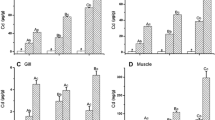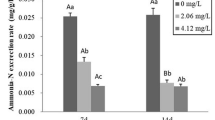Abstract
Effects of acute exposure to sublethal waterborne cadmium (Cd) on energy homeostasis in filter-feeding fishes have rarely been studied. The response patterns of energy substances were investigated in juvenile silver carp (Hypophthalmichthys molitrix) exposed to sublethal waterborne Cd for 96 h. The results showed the 96hLC50 of Cd on juvenile silver carp was 1.723 mg/L. Sublethal acute exposure of Cd significantly affected the energy homeostasis of juvenile silver carp, including increase in plasma glucose and lactate, and decrease in plasma triglyceride, muscle glycogen and triglyceride and liver glycogen. The results indicated that glycogen and triglyceride prior to protein were mobilized to meet the increased demands for detoxication and repair mechanism to sublethal waterborne Cd exposure, and glycogen level depleted faster and restored slower in the liver than in the white muscle in juvenile silver carp.



Similar content being viewed by others
References
Almeida JA, Novelli ELB, Dal Pai Silva M, Alves Júnior R (2001) Environmental cadmium exposure and metabolic responses of the Nile tilapia, Oreochromis niloticus. Environ Pollut 114:169–175
Annabi A, Messaoudi I, Kerkeni A, Said K (2009) Comparative study of the sensitivity to cadmium of two populations of Gambusia affinis from two different sites. Environ Monit Assess 155:459–465
Barton BA (2002) Stress in fishes: a diversity of responses with particular reference to changes in circulating corticosteroids. Integr Comp Biol 42:517–525
Bendell LI (2010) Cadmium in shellfish: The British Columbia, Canada experience – a mini-review. Toxicol Lett 198:7–12
Brown DA, Bay SM, Patrick Hershelman G (1990) Exposure of scorpionfish (Scorpaena guttata) to cadmium: effects of acute and chronic exposures on the cytosolic distribution of cadmium, copper and zinc. Aquat Toxicol 16:295–310
Campbell HA, Handy RD, Sims DW (2002) Increased metabolic cost of swimming and consequent alterations to circadian activity in rainbow trout (Oncorhynchus mykiss) exposed to dietary copper. Can J Fish Aquat Sci 59:768–777
Cao L, Huang W, Liu J, Yin X, Dou S (2010) Accumulation and oxidative stress biomarkers in Japanese flounder larvae and juveniles under chronic cadmium exposure. Comp Biochem Physiol C 151:386–392
Cattani O, Serra R, Isani G, Raggi G, Cortesi P, Carpene E (1996) Correlation between metallothionein and energy metabolism in sea bass, Dicentrarchus labrax, exposed to cadmium. Comp Biochem Physiol C 113:193–199
Chen X (1991) Acute toxicity and safe concentration evaluation of cadmium to fry, juvenile and fingerling of bighead carp Aristichthys nobills. Environ Sci Technol (4):5–8
Chen QL, Gong Y, Luo Z, Zheng JL, Zhu QL (2013) Differential effect of waterborne cadmium exposure on lipid metabolism in liver and muscle of yellow catfish Pelteobagrus fulvidraco. Aquat Toxicol 142–143:380–386
Chowdhury MJ, Baldisserotto B, Wood CM (2005) Tissue-specific cadmium and metallothionein levels in rainbow trout chronically acclimated to waterborne or dietary cadmium. Arch Environ Contam Toxicol 48:381–390
De Smet H, Blust R (2001) Stress responses and changes in protein metabolism in carp Cyprinus carpio during cadmium exposure. Ecotoxicol Environ Saf 48:255–262
Ferrari L, Eissa BL, Salibián A (2011) Energy balance of juvenile Cyprinus carpio after a short-term exposure to sublethal water-borne cadmium. Fish Physiol Biochem 37:853–862
Garcia-Santos S, Fontaínhas-Fernandes A, Monteiro SM, Wilson JM (2013) Effects of exposure to cadmium on some endocrine parameters in Tilapia, Oreochromis niloticus. Bull Environ Contam Toxicol 90:55–59
Garcia-Santos S, Monteiro S, Malakpour-Kolbadinezhad S, Fontaínhas-Fernandes A, Wilson J (2015) Effects of Cd injection on osmoregulation and stress indicators in freshwater Nile tilapia. Comp Biochem Physiol C 167:81–89
Garg S, Gupta RK, Jain KL (2009) Sublethal effects of heavy metals on biochemical composition and their recovery in Indian major carps. J Hazard Mater 163:1369–1384
Hontela A, Daniel C, Ricard AC (1996) Effects of acute and subacute exposures to cadmium on the interrenal and thyroid function in rainbow trout, Oncorhynchus mykiss. Aquat Toxicol 35:171–182
Hou L, Ma G (2002) Studies on the acute toxicity of cdmium and zinc to grass carp (Ctenopharyngodon idellus) fingerling and their joint action. Freshw Fish 32:44–46
Huang C, Chen QL, Luo Z, Shi X, Pan YX, Song YF, Zhuo MQ, Wu K (2014) Time-dependent effects of waterborne copper exposure influencing hepatic lipid deposition and metabolism in javelin goby Synechogobius hasta and their mechanism. Aquat Toxicol 155:291–300
Ings JS, Oakes KD, Vijayan MM, Servos MR (2012) Temporal changes in stress and tissue-specific metabolic responses to municipal wastewater effluent exposure in rainbow trout. Comp Biochem Physiol C 156:67–74
Lin YS, Tsai SC, Lin HC, Hsiao CD, Wu SM (2011) Changes of glycogen metabolism in the gills and hepatic tissue of tilapia (Oreochromis mossambicus) during short-term Cd exposure. Comp Biochem Physiol C 154:296–304
Liu J, Xie P (2003) Direct control of microcystis bloom through the use of planktivorous carp-closure experiments and lake fishery practice. Ecol Sci 22:193–196
Milligan CL (1996) Metabolic recovery from exhaustive exercise in rainbow trout. Comp Biochem Physiol A 113:51–60
Mommsen T, Vijayan M, Moon T (1999) Cortisol in teleosts: dynamics, mechanisms of action, and metabolic regulation. Rev Fish Biol Fish 9:211–268
Polakof S, Médale F, Skiba-Cassy S, Corraze G, Panserat S (2010) Molecular regulation of lipid metabolism in liver and muscle of rainbow trout subjected to acute and chronic insulin treatments. Domest Anim Endocrinol 39:26–33
Pretto A, Loro VL, Morsch VM, Moraes BS, Menezes C, Santi A, Toni C (2014) Alterations in carbohydrate and protein metabolism in silver catfish (Rhamdia quelen) exposed to cadmium. Ecotoxicol Environ Saf 100:188–192
Rana SVS (2014) Perspectives in endocrine toxicity of heavy metals – a review. Biol Trace Elem Res 160:1–14
Sadeghi P, Kazerouni F, Savari A, Movahedinia A, Safahieh A, Ajdari D (2015) Application of biomarkers in Epaulet grouper (Epinephelus stoliczkae) to assess chromium pollution in the Chabahar Bay and Gulf of Oman. Sci Total Environ 518–519:554–561
Sandhu N, McGeer JC, Vijayan MM (2014) Exposure to environmental levels of waterborne cadmium impacts corticosteroidogenic and metabolic capacities, and compromises secondary stressor performance in rainbow trout. Aquat Toxicol 146:20–27
Sapolsky RM, Romero LM, Munck AU (2000) How do glucocorticoids influence stress responses? Integrating permissive, suppressive, stimulatory, and preparative actions. Endocr Rev 21:55–89
Sfakianakis DG, Renieri E, Kentouri M, Tsatsakis AM (2015) Effect of heavy metals on fish larvae deformities – a review. Environ Res 137:246–255
Soengas JL, Agra-Lago MJ, Carballo B, Andrés MD, Veira JAR (1996) Effect of an acute exposure to sublethal concentrations of Ccadmium on liver carbohydrate metabolism of atlantic salmon (Salmo salar). Bull Environ Contam Toxicol 57:625–631
Sokolova IM, Frederich M, Bagwe R, Lannig G, Sukhotin AA (2012) Energy homeostasis as an integrative tool for assessing limits of environmental stress toleracne in aquatic invertebrates. Mar Environ Res 79:1–15
Vijayan MM, Pereira C, Moon TW (1994) Hormonal stimulation of hepatocyte metabolism in rainbow trout following an acute handling stress. Comp Biochem Physiol C 108:321–329
Vijayan MM, Raptis S, Sathiyaa R (2003) Cortisol treatment affects glucocorticoid receptor and glucocorticoid-responsive genes in the liver of rainbow trout. Gen Comp Endocrinol 132:256–263
Wang G, Zhou Q, Hu X, Hua T, Li F (2007) Single and joint toxicity of perchloroethylene and cadm ium on Ctenopharyngodon idellus. Chin J Appl Ecol 18:1120–1124
Weis J, Smith G, Zhou T (1999) Altered predator/prey behavior in polluted environments: implications for fish conservation. Environ Biol Fish 55:43–51
Weis JS, Smith G, Zhou T, Santiago-Bass C, Weis P (2001) Effects of contaminants on behavior: biochemical mechanisms and ecological consequences. Bioscience 51:209–217
Wu SM, Deng AN, Lee YC (2006) Changes of cortisol and metallothionein upon cadmium exposure and handling stressed in tilapia (Oreochromis mossambicus). J Fish Soc Taiwan 33:1–9
Wu SM, Shih MJ, Ho YC (2007) Toxicological stress response and cadmium distribution in hybrid tilapia (Oreochromis sp.) upon cadmium exposure. Comp Biochem Physiol C 145:218–226
Yi Y, Wang Z, Zhang K, Yu G, Duan X (2008) Sediment pollution and its effect on fish through food chain in the Yangtze river. Int J Sediment Res 23:338–347
Yin Y (1979) Primary review of acute toxicity of 19 toxicants common used to fish. In: The institute of hydrobiology, Hubei Province (ed) Reports on environmental protection and Aquatic organisms, pp 1–20
Zahedi S, Mirvaghefi A, Rafati M, Mehrpoosh M (2013) Cadmium accumulation and biochemical parameters in juvenile persian sturgeon, Acipenser persicus, upon sublethal cadmium exposure. Comp Clin Pathol 22:805–813
Zhang T, Zhang Y, Li D, Xiao T, Li J (2013) Exposure of silver carp (Hypophthalmichthys molitrix) to environmentally relevant levels of cadmium: hematology, muscle physiology, and implications for stock enhancement in the Xiangjiang river (Hunan, China). Sci China Ser C 56:66–72
Acknowledgments
This study was supported by the National Natural Science Foundation of China (No. 31100282) and Special Fund for Agro-Scientific Research in the Public Interest (No. 201503108).
Author information
Authors and Affiliations
Corresponding authors
Rights and permissions
About this article
Cite this article
Pi, J., Li, X., Zhang, T. et al. Effects of Acute Exposure to Sublethal Waterborne Cadmium on Energy Homeostasis in Silver Carp (Hypophthalmichthys molitrix). Bull Environ Contam Toxicol 97, 497–503 (2016). https://doi.org/10.1007/s00128-016-1896-2
Received:
Accepted:
Published:
Issue Date:
DOI: https://doi.org/10.1007/s00128-016-1896-2




